Connecting Mythology with Environment:
Interview with Miwa Komatsu
By Nina Mdivani
In her bold and dynamic paintings young Japanese artist Miwa Komatsu (b.1984) draws a direct line between old Japanese mythology and contemporary environmental issues. Being appointed an ambassador of goodwill by the Ministry of the Environment of Japan in 2021 Komatsu succeeds in drawing public attention to the quality of our connection to nature and its forces. She builds upon the Japanese notion of communion with nature as being an integral part of human life, using her personal as well as more traditional Shinto symbology to guide her viewers to a more harmonious and pure living. As a rising woman artist in Japan Komatsu has broken some stereotypes and envisions to achieve more. If art could still be as a social pact between a creator, a viewer and a society it needs to not only please an eye, but also to guide — Komatsu takes this direction.

Miwa Komatsu, photo courtesy of the artistNina Mdivani: Miwa, let’s start from your beginnings. You were born in Sakaki, province Nagano – Japanese countryside, did this surrounding different from busy city life influence your art? And if so, how?
Miwa Komatsu: Nagano Prefecture is where I grew up and have lived there until I was 18 years old. This is the prefecture in Japan that has the highest mountains in the country. It means that one gets a narrower view of the sky and it always feels like the mountains are close to you, there is a great sense of earth energy nourishing people who live there. This place felt close to the heavens and therefore I felt that I could establish a connection with the outer space, linking Earth and Sky, cosmic forces and me. Being so high up enabled me to imagine a deep sense of connection with the outside world, far beyond physical borders.
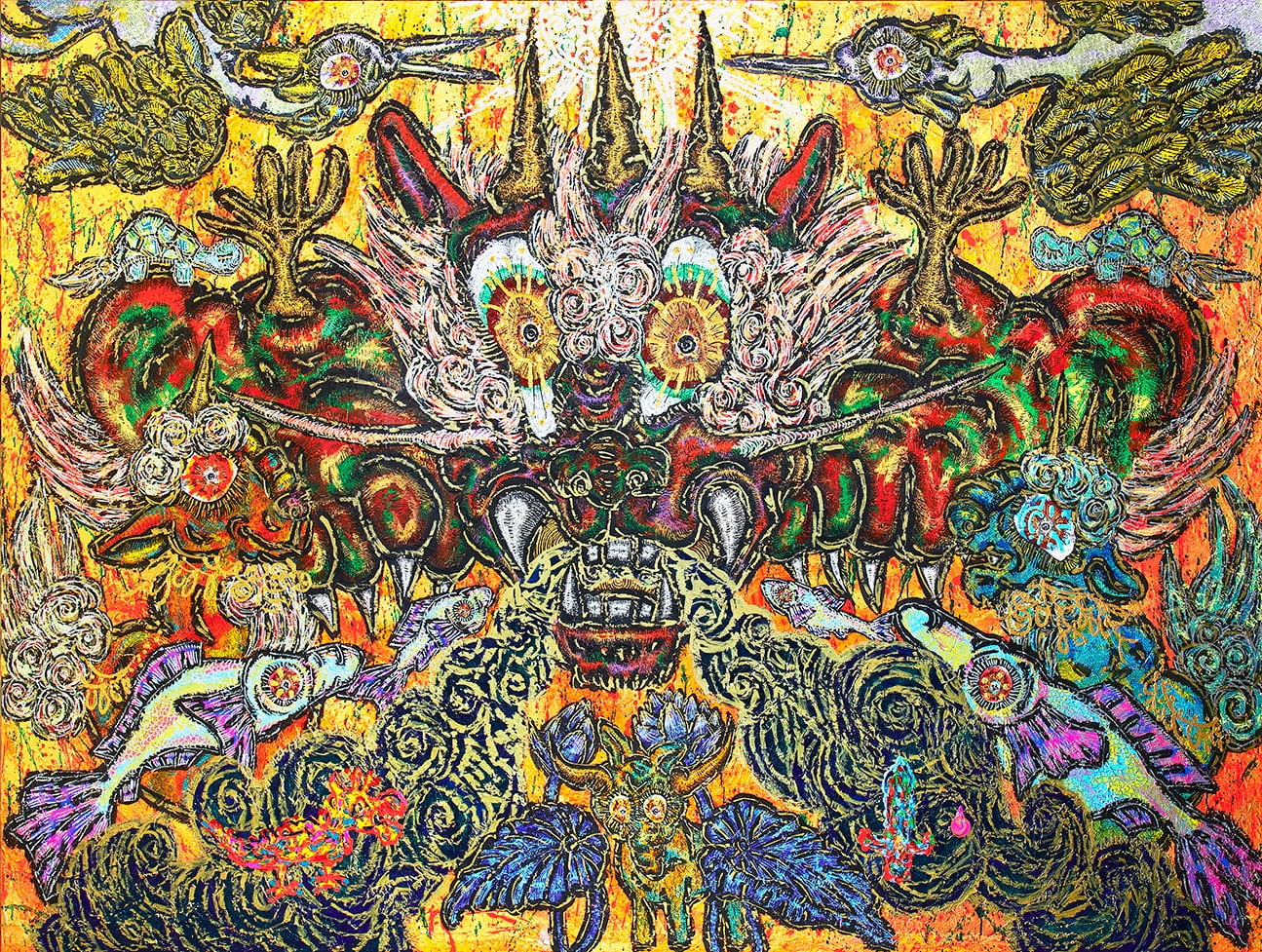
Miwa Komatsu, All May Become Dragons
世人皆可成為龍
だれしも龍となる
193.9 × 259.1 cm , Acrylic Paint , Gofun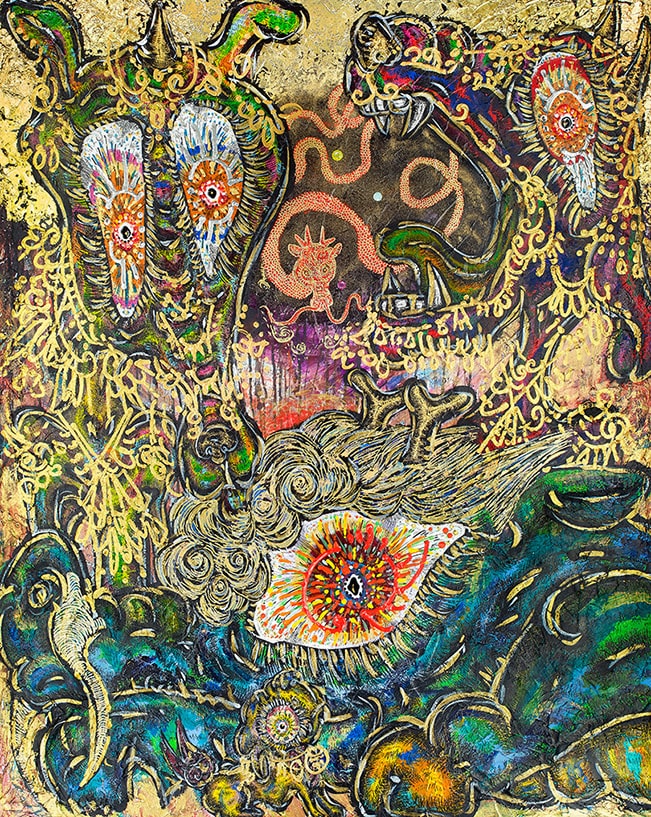
Miwa Komatsu, Thundering Footfalls of Guardian Deity in Cavern, Full Moon
滿月之日,神獸們鳴聲震地,響徹鍾乳石洞
鍾乳洞に響く神獣達の地鳴りと、満月の日
162.0 × 130.3 cm , Acrylic Paint , Gold leaf , Pen , Mixed MediaNM: What can you say about the training you have received at the Joshibi University of the Arts and Design? Who was your favorite teacher? Who are Japanese and non-Japanese artists you feel have influenced you as an art student?
MK: I started studying copper plate engraving, this was the focus of my study. The name of my favorite teacher was Orgawa Sensei, together with teaching me the techniques he had an impact in me with his wisdom. At Joshibi they gave me a very thorough grounding in the history of art and also historically it has been a progressive all-women school, strongly supporting women in the arts, an exception for Japan. Studying art history enabled me to then position my own work. As I work on my paintings, I do not separate European or Japanese art, I try to speak of universal truths, through the evolution of art that happened in different cultures. One major influence for me is Kukai also known as Kobo Daishi (774-835), a monk, calligrapher, and poet, he’s important for introducing Shingon, a branch of Buddhism to Japan from China and he’s also known for his exquisite scrolls. I have encountered these scrolls during a recent trip to Koyasan, a group of 1200 year-old monasteries. When I went there I spent some time in deep meditation and prayer, dwelling on how Kukai calligraphy is rooted into the basic prayers. And looking at those lines and meditating on them, I felt a profound sense of the way in which the work of an artist lives on after they pass away and can have an effect on many generations into the future. So, this piece of calligraphy was 1200 years old and I was there looking at it and experiencing a profound sense of my own mortality if you like.

Miwa Komatsu, Keep Lighting, Keep Walking, 2018, acrylic on canvas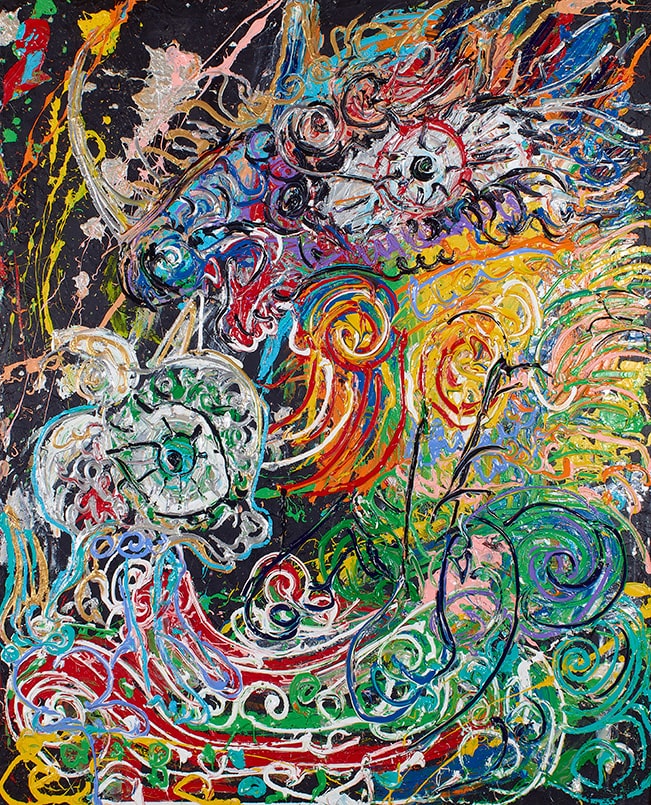
Miwa Komatsu, Mountain Wind Embrace ~ Past to Future
擁抱山風~從過去到未來
山風抱擁〜過去から未来へ
100F , Acrylic PaintNM: I have read that along with using acrylic paints you have used as your medium copperplate engraving and porcelain. How do you decide which particular material goes with a particular work? Also performing painting in a live event is another characteristic of your practice, how do you decide which painting you are about to ‘perform’?
MK: Right. So, in the beginning when I entered the art school, I was studying Western artistic traditions, but in the process, I found that I was more attuned to old Japanese concepts. To me very fine and precise line drawing was of particular interest and I continued to work with this medium. My interest in other materials grew from that. Over time I have tried various media including VR and porcelain, but now I mostly work with acrylic. Each medium has its own history and its own power. I decide the medium based on the concept behind the work, not the other way around.
I do not sketch or do any prep work. I attempt to get to the visions that are behind the artwork, praying and meditating every morning is part of my method. It is similar to fixing on canvas images of things dropping down from heaven into my head. They could be kind of coded in a way, I decode them by turning them into art and symbols.
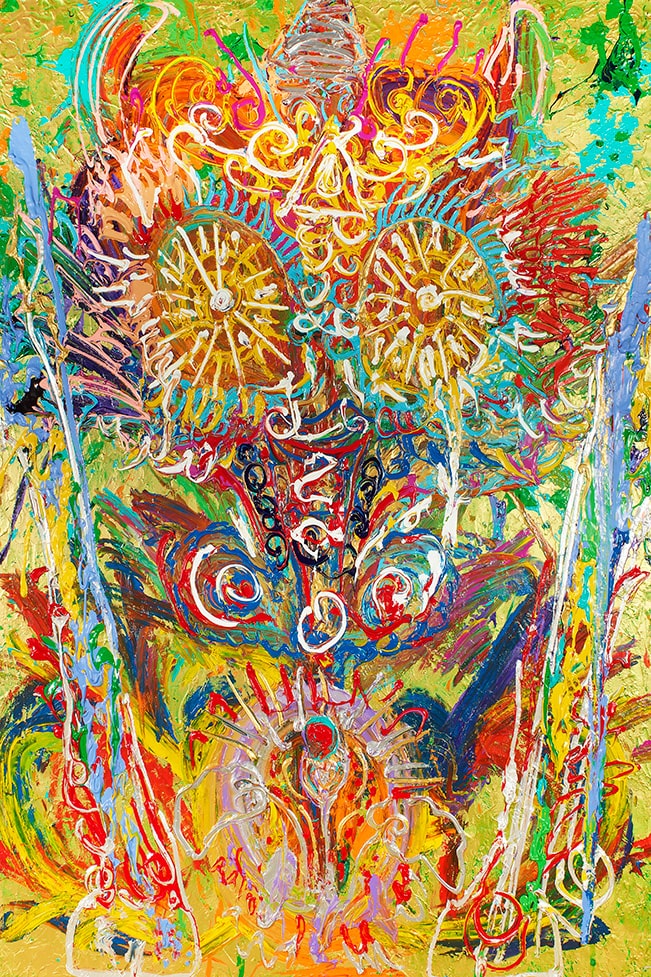
Miwa Komatsu, With the Voice of the Wind
與風聲同行
風の声と共に
194.0 × 130.3 cm , Acrylic Paint
Miwa Komatsu, Father's Example, Mother's Heart, Children's Love
父之姿、母之心、子之愛
父の姿、母の心、子の愛
194.0 × 259.0 cm , Acrylic Paint , Mixed MediaNM: So, it’s a spiritual kind of approach to art?
MK: Yes, I am is not using my brain, it’s more like using heart and her soul, channeling this stuff, and that’s kind of a life mission.
NM: You have been exhibited globally since your graduation from grad school in 2005 including British Museum, Museum of Tetsu, Kitano Museum of Art Annex and Ueda City Museum of Art. What has been the most important venue for you personally?
MK: I am sometimes asked what was the best place where I have exhibited or painted. I do not differentiate between them, because each one of them had a specific meaning or a kind of role that they have played in my journey. So, I say they all had a sacred blessing for me. Probably the Izumo Shrine would be the most important venue so far.
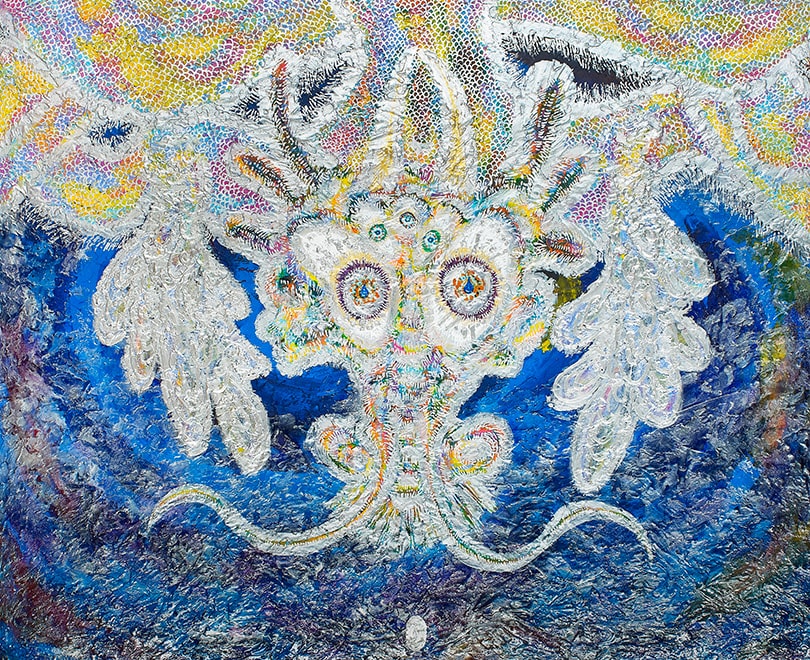
Miwa Komatsu, Helping the Thousand Arms Save
千手的幫助
千手の手助け
100F , Acrylic PaintNM: Can you tell me more about the work you have dedicated to the Izumo Taisha Shrine? It is one of the most important Shinto shrines in the country. How did this come about and what is the main concept behind the work?
MK: Izumo is a place in Japan that has echoes of very ancient myths of this land. I went to pray in Izumo shrine in 2013. The shrine is located in a valley between the mountains and what I observed were the rays of sun coming up from below and not from above, due to the unique location of the Shrine, sunrays were beaming up into the clouds. And this was a very moving moment for me, making me realize the power of color. I felt that this power is not specific to Shinto, but it also is present in other religions. What became clear to me was that through using color in my art, I would be able to connect to people all over the world. I started to use colors from that point on and that was a big turning point in my career.
I went to the Shrine on a pilgrimage during the Shikinen Sengu, an important Shinto festival. This specific place and time is surrounded by many elements of the ancient Japanese mythology. This was a chance for me as a Japanese person to rediscover my Japanese roots. I also feel that this experience helped me to find my role in life and my mission from the heavens as it were.

Miwa Komatsu, photo courtesy of the artistNM: What role does mythology and Japanese folklore play in your art? Are there any recurrent figures in your works that come from mythology?
MK: In the world of Japanese mythology there are many different gods and creatures, there are spirit beings and they all go through amazing journeys and adventures and these stories are described in Kojiki and Fudoki manuscripts. And so, these creatures seem fantastical to us because they are considered as such. But for me they are still living, these supernatural beings are still amongst us. Therefore, mythology isn’t something that’s restricted to the ancient past. Rather, it’s connected to the present and to the future. They are kind of extra-dimensional entities, transcending space and time.
There’s a character that frequently appears in my newest works, which is called Komainu, a pair of guardian lion dogs. This figure is based on an ancient Japanese wolf, now extinct. When I was a child in the Nagano Prefecture once I got lost in the forest and it became dark. One of these mythical creatures appeared to me and guided me home, saving me from being lost in the forest. And so, to this day, I repeatedly draw this guardian lion dog and wolf spirit. The symbolic meaning of that is showing mankind the proper way to live, the correct path. This dog is guiding mankind in that way.
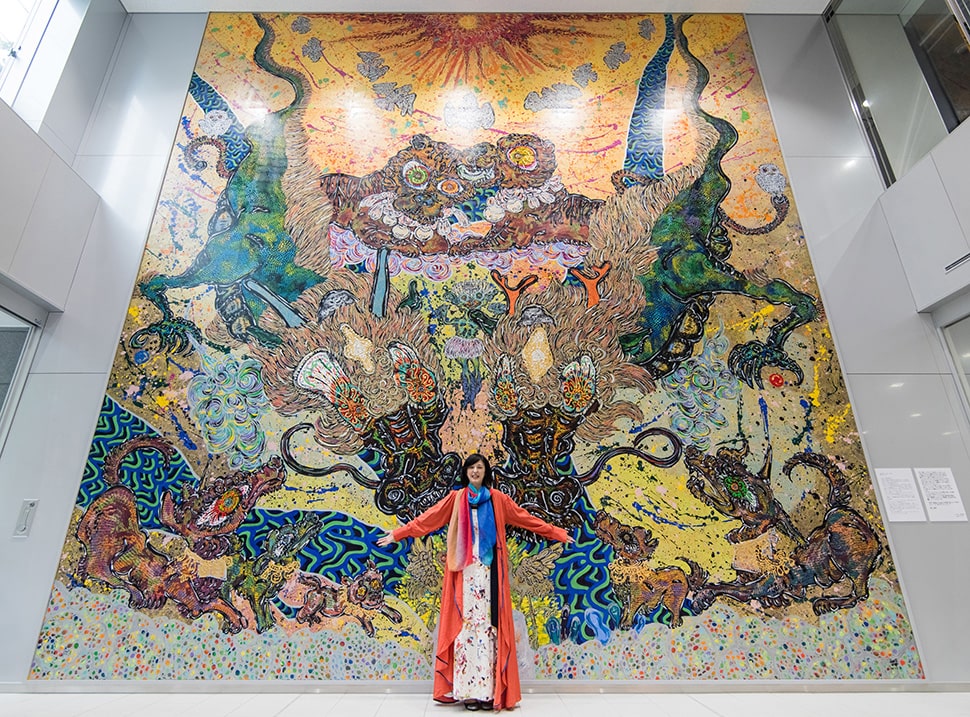
Miwa Komatsu, Guardian Deity Anthem "Ganju Sakkora Hojo Sansa"
神獸讚美歌「春鷹捎來幸福,土壤豐盛」
神獣讃歌「巖鷲幸呼来豊穣さんさ」
700.0 × 700.0 cmNM: I know you have been involved in the Earth Summit as well as in a few charity events recently, can you talk more about your participation?
MK: Last year I participated in a 24-hour television marathon, the painting I did live there was then auctioned and the proceeds went to charity supporting social welfare, disaster recovery support and medical support for COVID-19 patients. This August I also participated in the Earth Shot conference. This conference was broadcasted simultaneously to audiences in Japan and the USA and was hosted by Kaoru Hayashi, president of Digital Garage with speakers including Stewart Brand, Taro Kono (Minister for Administrative Reform), Takuya Hirai (Minister for Digital Transformation), Mitsuhiro Takemura (President, Takemura Juku School), Shinjiro Koizumi (Minister of the Environment) and Ms. Audrey Tan (Digital minister of Taiwan). Such a public conversation about the environment is important, but I also feel that art-making is a contribution to society, that it’s a medium for touching people’s hearts and imparting a positive message. And I am very grateful for the blessing of being able to make art.
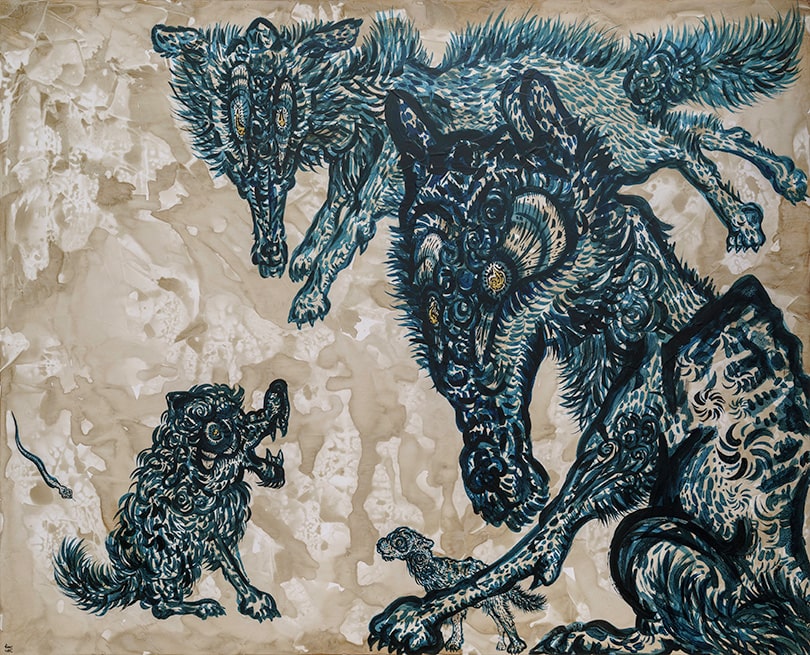
Miwa Komatsu, あまねく山犬の営みと恩恵
130.3 × 162.0 cm , Acrylic Paint , Mixed MediaNM: As you are aware there is a considerable global discussion about the contemporary role of the artist in a global society troubled by the pressing ecologic and humanitarian issues. Where do you see yourself in these struggles? What is your own personal mission and role?
MK: I am always thinking about environmental issues. As mentioned before, I grew up in the Nagano Prefecture, surrounded by nature, but I have also travelled and I have seen the effects of desertification, loss of natural habitats, and the effects that this has on animals. I have observed deep wounds of civil wars, especially after meeting child soldiers in Africa. But so, then this makes us think, you know, what is it? What can we do?
And then I think there’s a limit to what we can achieve through material things. Well, rather, happiness comes from being in nature, being able to find release for your heart and soul. And in that state, you’re able to connect with what your role in life is, what your mission in life should be. That is the way to happiness and that is the way to proceed. Our being is a very important part of it. So, I see the art I create as being integral to my way of living. I harness the energy of nature and put it into the art. And so, I think that act in itself is making a contribution.
In addition, this year the Ministry of the Environment of Japan has selected me as its ambassador, in an effort to raise awareness about environmental issues, including during the Earth Shot conference I mentioned before.
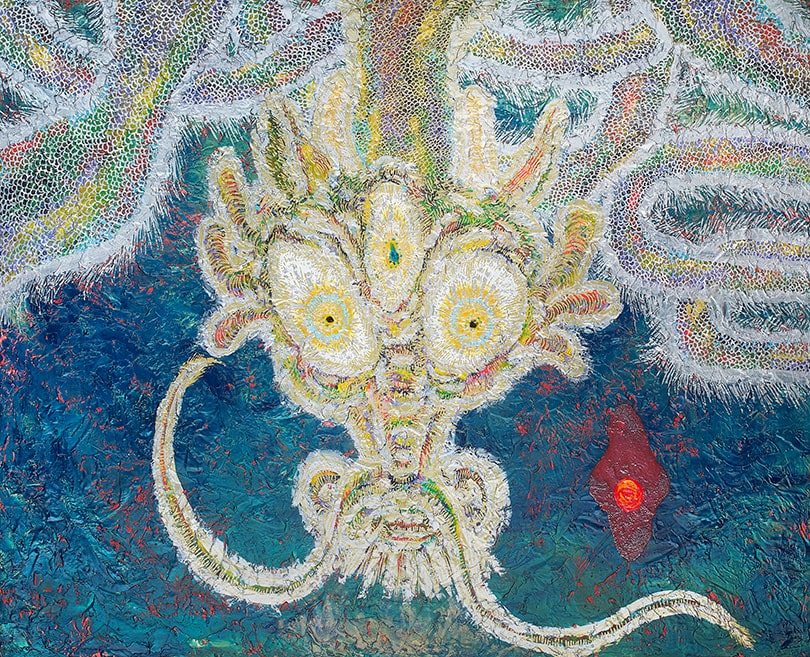
Miwa Komatsu, Encounter in the Waterways
在深處遇見
深層で出会う
100F , Acrylic Paint , Mixed MediaNM: As a woman artist I have to ask you whether you position yourself as a feminist artist? Does your gender play any role in your work or in your artistic identity? Have you ever encountered any difficulty in Japan as a woman artist that a man would not have encountered? Did you perceive any difference to the art you create abroad because of your gender?
MK: Because women experience menstruation, we have a different biological makeup when blood flows out of the body, very different from men, and that can affect the way we are. Also, in regards to meditation, it seems that females tend to be more affected by the moon than men. So, on a full moon, you’re able to kind of achieve a higher level of control over your body. And so I can say I become very sensitive to the energy depending on the moon. And I think, women in general tend to be more sensitive to natural energy. I am grateful for the fact that I am a woman because it allows me to channel this energy that comes into me from the natural or the supernatural spirit world.
Because I went to all-female art school, I can’t say that I have encountered any kind of barriers related specifically to my gender. Of course, in the beginning of 20th century Japan has experienced significant discrimination against women, but it was a mindset of the time globally as well, it wasn’t acceptable for women to go and study art. And therefore the Joshibi School of Arts and Design was founded in order to meet that need in 1910. And, you know, the history continues to this day, because the women artists in Japan still constitute a minority.
NM: Historically Japanese culture has always shown a deep connection to nature be it in the contemplative poems of Basho or traditional schools of painting such as Yamato-e and the Kano school. Do you feel that this has changed in the contemporary Japanese arts and culture?
MK: Many years ago, I had the pleasure of visiting the Naoshima island Island and its famous outdoor art museum. There I saw the potential for art to become one with nature. And this got me thinking about the coexistence of art and nature and the connection between the two. And because Japan is a nation of islands, it has this long tradition of incorporating things from overseas, then redesigning and improving them. Even though this very kind of industrial image of Japan exists globally, 70% of the landmass in Japan is covered by forest. So, I think we are still connected to nature in a deep and continuous way. So it goes on, and there is a potential of coexistence between art and humans, even in their digital reality. So, my main message is the message of hope.

